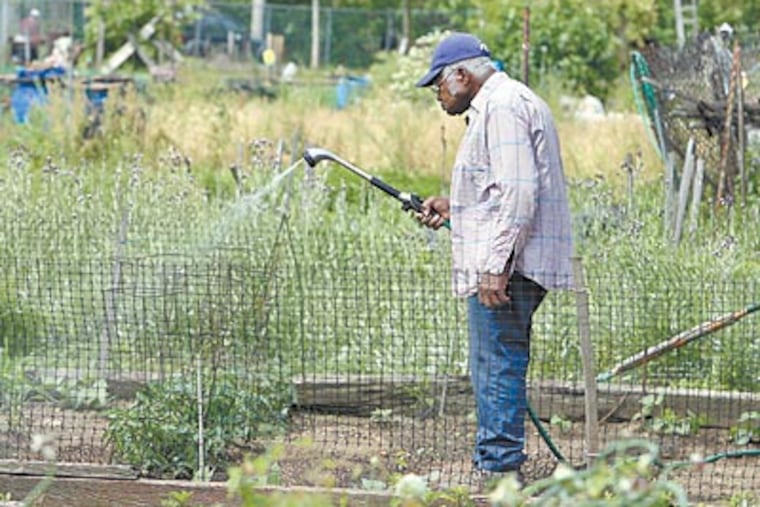Keystone Gardens: Deep-rooted sources of food, pride
In the morning sunshine, Darlene Marcus walks between the rows of garden plots at a massive green oasis in North Philadelphia, as she has during growing seasons for about 20 years.

In the morning sunshine, Darlene Marcus walks between the rows of garden plots at a massive green oasis in North Philadelphia, as she has during growing seasons for about 20 years.
Marcus pointed to the vegetables starting to sprout at Glenwood Green Acres, the largest community garden, and one of the oldest, in Philadelphia.
"We have collard greens, lettuce, peppers, eggplant, squash, string beans . . .," Marcus said one recent day, her voice interrupted by the rumble of a passing Amtrak train, as she looked over the 90 rectangular plots on this 3.5-acre stretch.
"We have okra over here, we even have blackberries," said Marcus, a cochairwoman of the garden, which her grandfather helped found nearly 30 years ago.
It's a busy planting time for Marcus and her fellow gardeners. "The weather is getting where we want it," she said.
In a city with about 400 community gardens, Glenwood Green Acres - which spans Glenwood Avenue from 18th to 19th Streets and is bounded by railroad tracks - is held in a special class by the Pennsylvania Horticultural Society, which provides a variety of services to community gardens.
Glenwood Green Acres, on the site of a former whiskey factory, is one of nine Philadelphia gardens designated as Keystone Gardens.
Eileen Gallagher, a spokeswoman for the Horticultural Society, said the designation was for gardens distinguished by their large size, longevity, and commitment. The society gives them support and counseling so they can be self-sustaining over the long term.
The nine Keystone Gardens are an average size of one-quarter to one-half acre, officials said. The gardeners keep their produce and share it with neighbors and neighborhood groups. They contribute a portion of their produce to the City Harvest program, which was established by the Horticultural Society.
City Harvest has received more than 55,000 pounds of produce since its founding in 2006, Gallagher said.
In South Philadelphia, Ed Mitinger, 49, a leader at Southwark Community Garden, another Keystone Garden, walks through the 60 plots of flowers and vegetables on about an acre at 311-33 Christian St.
Mitinger, who also manages a natural-foods store, said Southwark had been in operation for 33 years. Besides focusing on plants, the Southwark garden aims to beautify the area, Mitinger said.
One wall facing the garden consists of a large mural of mirrors arranged in an abstract design.
"You get to enjoy some of the more expanded areas of the garden, whether you want to have a picnic here on a cool evening or read the Sunday paper," Mitinger said.
Among the features there are a children's area, a gazebo, paved areas, an apiary humming with bees, a fire pit, and solar panels.
"All the things you see here, the gazebo and the fencing and just the general aesthetic of the garden, didn't arrive here in five years' time," Mitinger said. "They've been kind of accumulated. We have the advantage of having that length of time over which to accumulate expertise and means."
Gallagher of the Horticultural Society said the keys to making the gardens a lasting part of the community were careful planning, coordination, and securing the title to the land.
The Neighborhood Gardens Association/A Philadelphia Land Trust, a nonprofit group, is dedicated to the long-term preservation of community gardens and open space in low- and moderate-income neighborhoods.
Terry Mushovic, executive director of the association, said the group's primary purpose was to help community gardeners secure title to or take ownership of the land they use.
Mushovic said many of the gardens started in the 1970s and '80s were used by groups "just squatting on lots."
"We started seeing some of them being sold off for development projects by the city and private individuals," Gallagher said. "We wanted the gardeners to be aware of who owned the lots and what their options were."
Mushovic said that the association held title to or owned 30 of the community gardens and that the majority of them were donated and transferred to the association as gifts. She said this allowed the communities to focus on gardening.
The association, which is funded by local foundations and individual donations, also helps the groups acquire water lines and liability insurance, Mushovic said.
At Southwark, gardener Gwen MacDonald, 36, was taking in the beauty of the place. She was gazing at the new plants and some of the early flowers. Some of the plots were showing the first sprouts and blossoms of the season.
"It's a gorgeous green space," she said. "It's beautiful, a great community of people. . . . This is an oasis."
At Glenwood, Viery Ricketts, cochairwoman of the garden, was surveying the freshly planted plots. She said she relished the growing season.
"Every year that I plant and it grows, I have the same expression," Ricketts said. "I scream and holler when the first bud comes up, and I jubilee when the first fruit gets picked."